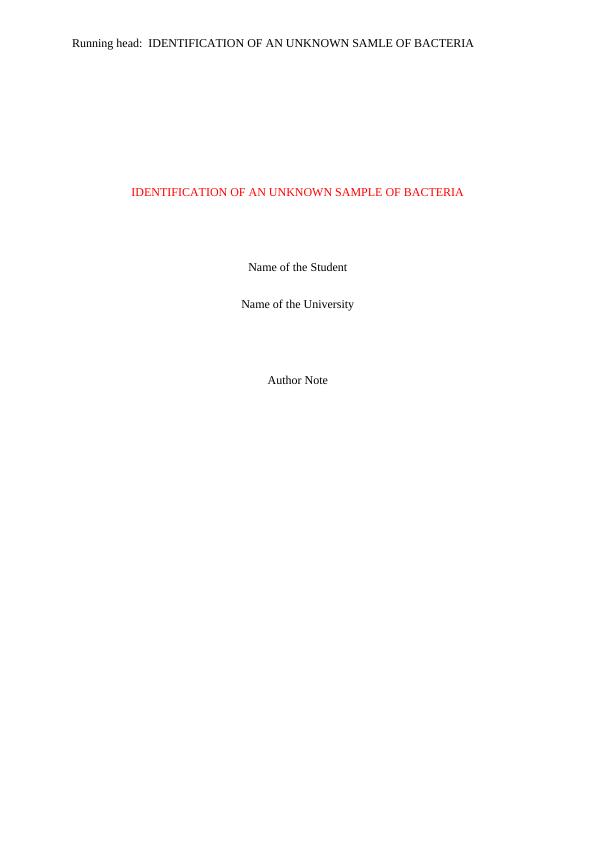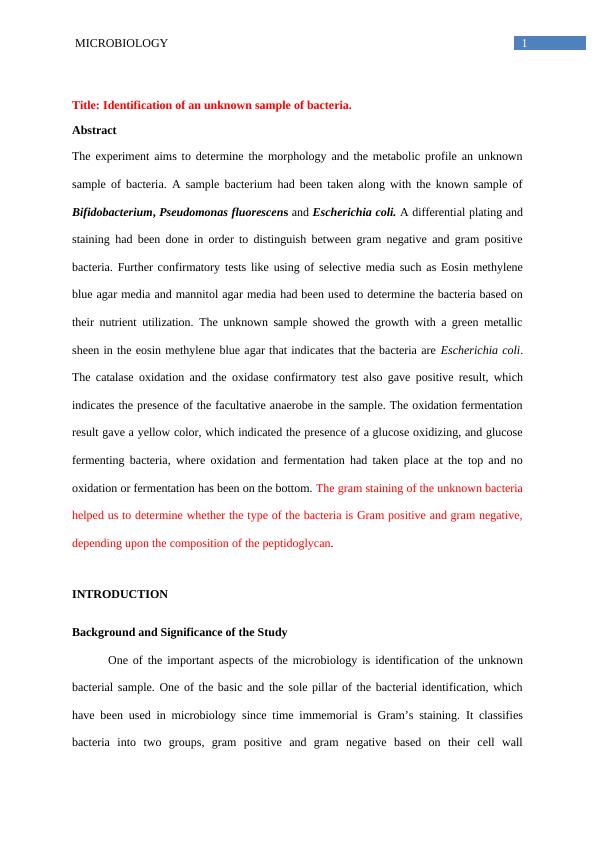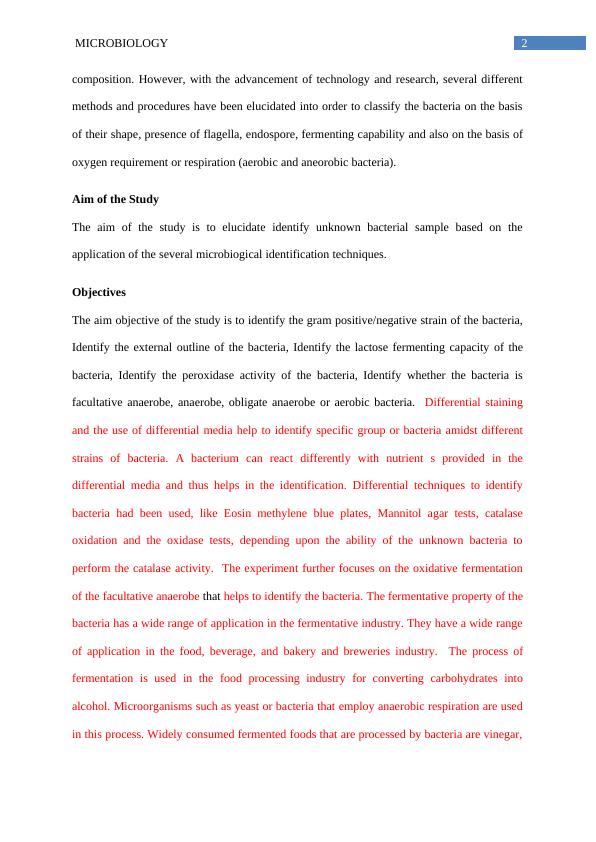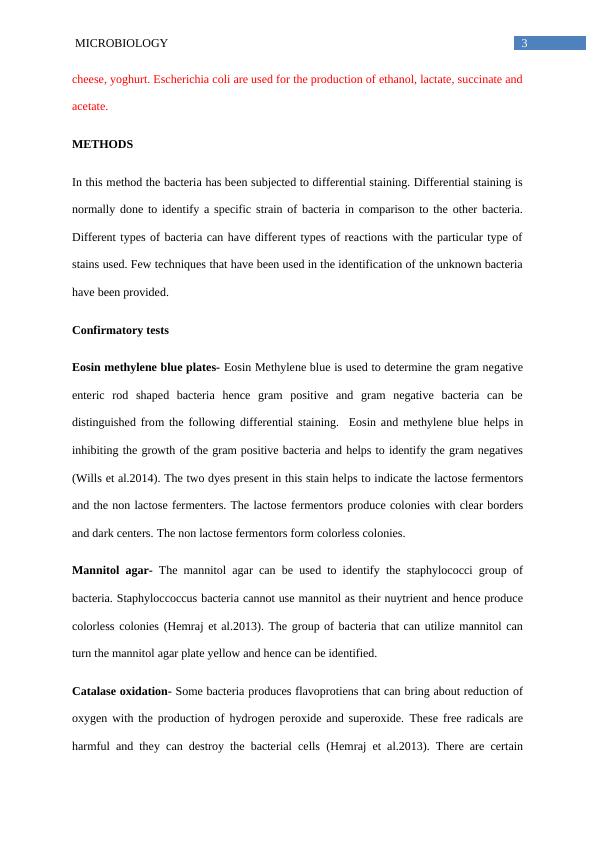Ask a question from expert
Microbiology Assignment | Morphology of Bacteria
13 Pages3192 Words249 Views
Added on 2019-11-20
Microbiology Assignment | Morphology of Bacteria
Added on 2019-11-20
BookmarkShareRelated Documents
Running head: IDENTIFICATION OF AN UNKNOWN SAMLE OF BACTERIAIDENTIFICATION OF AN UNKNOWN SAMPLE OF BACTERIAName of the StudentName of the UniversityAuthor Note

1 MICROBIOLOGYTitle: Identification of an unknown sample of bacteria.AbstractThe experiment aims to determine the morphology and the metabolic profile an unknownsample of bacteria. A sample bacterium had been taken along with the known sample ofBifidobacterium, Pseudomonasfluorescens and Escherichia coli. A differential plating andstaining had been done in order to distinguish between gram negative and gram positivebacteria. Further confirmatory tests like using of selective media such as Eosin methyleneblue agar media and mannitol agar media had been used to determine the bacteria based ontheir nutrient utilization. The unknown sample showed the growth with a green metallicsheen in the eosin methylene blue agar that indicates that the bacteria are Escherichia coli.The catalase oxidation and the oxidase confirmatory test also gave positive result, whichindicates the presence of the facultative anaerobe in the sample. The oxidation fermentationresult gave a yellow color, which indicated the presence of a glucose oxidizing, and glucosefermenting bacteria, where oxidation and fermentation had taken place at the top and nooxidation or fermentation has been on the bottom. The gram staining of the unknown bacteriahelped us to determine whether the type of the bacteria is Gram positive and gram negative,depending upon the composition of the peptidoglycan. INTRODUCTIONBackground and Significance of the StudyOne of the important aspects of the microbiology is identification of the unknownbacterial sample. One of the basic and the sole pillar of the bacterial identification, whichhave been used in microbiology since time immemorial is Gram’s staining. It classifiesbacteria into two groups, gram positive and gram negative based on their cell wall

2 MICROBIOLOGYcomposition. However, with the advancement of technology and research, several differentmethods and procedures have been elucidated into order to classify the bacteria on the basisof their shape, presence of flagella, endospore, fermenting capability and also on the basis ofoxygen requirement or respiration (aerobic and aneorobic bacteria). Aim of the StudyThe aim of the study is to elucidate identify unknown bacterial sample based on theapplication of the several microbiogical identification techniques.ObjectivesThe aim objective of the study is to identify the gram positive/negative strain of the bacteria,Identify the external outline of the bacteria, Identify the lactose fermenting capacity of thebacteria, Identify the peroxidase activity of the bacteria, Identify whether the bacteria isfacultative anaerobe, anaerobe, obligate anaerobe or aerobic bacteria. Differential stainingand the use of differential media help to identify specific group or bacteria amidst differentstrains of bacteria. A bacterium can react differently with nutrient s provided in thedifferential media and thus helps in the identification. Differential techniques to identifybacteria had been used, like Eosin methylene blue plates, Mannitol agar tests, catalaseoxidation and the oxidase tests, depending upon the ability of the unknown bacteria toperform the catalase activity.The experiment further focuses on the oxidative fermentationof the facultative anaerobe that helps to identify the bacteria.The fermentative property of thebacteria has a wide range of application in the fermentative industry. They have a wide rangeof application in the food, beverage, and bakery and breweries industry. The process offermentation is used in the food processing industry for converting carbohydrates intoalcohol. Microorganisms such as yeast or bacteria that employ anaerobic respiration are usedin this process. Widely consumed fermented foods that are processed by bacteria are vinegar,

3 MICROBIOLOGYcheese, yoghurt. Escherichia coli are used for the production of ethanol, lactate, succinate andacetate.METHODSIn this method the bacteria has been subjected to differential staining. Differential staining isnormally done to identify a specific strain of bacteria in comparison to the other bacteria.Different types of bacteria can have different types of reactions with the particular type ofstains used. Few techniques that have been used in the identification of the unknown bacteriahave been provided. Confirmatory testsEosin methylene blue plates-Eosin Methylene blue is used to determine the gram negativeenteric rod shaped bacteria hence gram positive and gram negative bacteria can bedistinguished from the following differential staining. Eosin and methylene blue helps ininhibiting the growth of the gram positive bacteria and helps to identify the gram negatives(Wills et al.2014). The two dyes present in this stain helps to indicate the lactose fermentorsand the non lactose fermenters. The lactose fermentors produce colonies with clear bordersand dark centers. The non lactose fermentors form colorless colonies. Mannitol agar- The mannitol agar can be used to identify the staphylococci group ofbacteria. Staphyloccoccus bacteria cannot use mannitol as their nuytrient and hence producecolorless colonies (Hemraj et al.2013). The group of bacteria that can utilize mannitol canturn the mannitol agar plate yellow and hence can be identified. Catalase oxidation- Some bacteria produces flavoprotiens that can bring about reduction ofoxygen with the production of hydrogen peroxide and superoxide. These free radicals areharmful and they can destroy the bacterial cells (Hemraj et al.2013). There are certain

End of preview
Want to access all the pages? Upload your documents or become a member.
Related Documents
Microbiology Assignment: Biosciencelg...
|8
|1692
|284
Identification of Unknown Bacterial Samples through Gram Staininglg...
|13
|2688
|454
Isolation and Characterization of Unknown Bacteria B Using Morphological and Biochemical Testslg...
|6
|2023
|228
Microbiology Study: Identification of Unknown Organisms from Bacterial Cultureslg...
|8
|1804
|438
MRSA Disease: Symptoms, Pathogenicity, Diagnosis, Treatment and Preventionlg...
|8
|1708
|285
Investigation of MRSA Infection in Neonatal Intensive Care Unit: Genotypic and Culture Approach Reveals Outbreak and Drug Resistancelg...
|15
|3121
|424